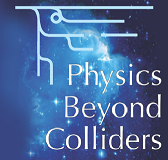Physics Beyond Colliders kickoff workshop

Recent results from the LHC shows that that the Standard Model works with a remarkable accuracy within the presently accessible energy range. However there is now overwhelming evidence for the existence of Dark Matter; a component of our Universe not described by the Standard Model. On the other hand, the fact that there we haven’t yet found signs of new physics at the LHC means that physicists may have to look more carefully in the lower energy cracks. As the renowned cosmologist Mikhail Shaposhnikov mentioned in his talk: "Whatever the LHC will bring us, we are in a “no lose” situation: New physics at the LHC - study it! No new physics at the LHC - a number of new experiments at high energy, precision, and high intensity frontiers, in cosmology and astrophysics will be needed - a lot to explore!"
CERN’s management has set up a study group to explore what else could be done with CERN’s accelerator complex to target fundamental physics questions, similar in nature to those addressed by high-energy colliders, but based on different types of beams and experiments. The given time-scale is out to around 2040. The study group is charged with pulling together interested parties, exploring the options at an appropriate depth with the aim of providing input to the next update to the European Strategy for Particle Physics in around 2019.
The kickoff meeting took place on 6th and 7th of September 2016 at CERN. For this meeting the team adopted a fairly loose bottom-up approach to survey the theoretical challenges along with the plans for upgrading the existing accelerator complex – including the PS and SPS - and experimental facilities. The next step was to invite proposals from the community, a selection of which were presented at the workshop. The meeting was well attended – registration was closed when the total passed 300!
From a theoretical perspective there are many prospects for new physics below the Fermi scale. One of them is based on the measurement of the electric dipole moment that could open a window on new physics and help to identify the energy scale where new physics may lie. The hunt for axions and axion-like particles, heavy neutral leptons, dark energy detection and searches for ultra-light dark matter are among the options that physicists consider in order to answer some of the open questions related to the “dark” component of our Universe.
It is clear that CERN’s priority over the coming years will be the full exploitation of the LHC firstly in its present guise and then from 2026 as the High Luminosity upgrade (HL-LHC). The LHC places stringent demands on intensity and related characteristics and a major upgrade of the injectors is planned to provide the requisite beams of the HL era. Despite this the LHC doesn’t actually use many protons. This leaves the other facilities open to exploit the considerable beam production capabilities of the accelerators and indeed the already diverse and far-sighted program spans ISOLDE, AD, nTOF, East Area, HiRadMat, AWAKE and the North Area.
A number of interesting ideas concern the North Area and the numerous beams on offer/available there. Some proposals target novel measurements at existing facilities such as precise measurements of the branching ratios (BRs) for the flavor-changing neutral current decays K → πννbar at NA62.
Others foresee completely new developments. Notable among these is the proposed SPS beam dump facility (BDF), a fixed-target facility foreseen to be situated at the North Area of the SPS. Beam dump in this context implies a target aimed at absorbing all incident protons and containing most of the cascade generated by the primary beam interaction. The aim is a general purpose fixed target facility, which in the initial phase is aimed at a general Search for Hidden Particles (SHiP) including heavy neutral leptons, as well as tau neutrino physics.
Precision measurement of the proton electric dipole moment (EDM) can be envisaged using a small 500 m circumference all electric storage ring. The physics motivation is strong, and from an accelerator standpoint challengingly interesting. Other options discussed included the search for dark photons using an electron beam dump and the exploration of fixed target possibilities at the LHC based either on crystal extraction or an internal gas jet. Partially stripped ions interacting with a LASER have the potential to provide a powerful gamma source.
On the non-accelerator side of things, axion and dark matter searches span an impressive range of possibilities. At one extreme are the plans for an international axion observatory (IAXO) based on a large superconducting toroid magnet, at the other are sensitive measurements on the short range interactions between macroscopic bodies that potentially provide a window on possible physics beyond the standard model.
To quote Carlo Rubbia: "I think Nature is smarter than physicists. We should have the courage to say: "Let Nature tell us what is going on". Our experience of the past has demonstrated that in the world of the infinitely small, it is extremely silly to make predictions as to where the next physics discovery will come from and what it will be. In a variety of ways, this world will always surprise us all. The next breakthrough might come from beta decay, or from underground experiments, or from accelerators. We have to leave all this spectrum of possibilities open and just enjoy this extremely fascinating science."
The workshop threw up a wide range of possibilities at various stages of development. The study team’s next challenge will be develop a strategy to harness the available resources to explore at an appropriate depth those proposals that meet the given criteria of exploiting the unique opportunities offered by CERN’s accelerator complex and scientific infrastructure, and being complementary to other initiatives in the world.
